|
|
Othello rules
Othello rules- Reversi and Othello use almost the same rules, (slight difference in opening or pass rules). But Othello is a copyrighted name thus you will find Teversi instead of Othello in some places.
Othello is a two-player strategy game: the Black against the
White. The playfield is a single coloured board of 8x8 squares.
Each player owns 64 discs, black on the one side and white on the
other one. For practical matters, each player has 32 discs at
his disposal but can be forced to hand some of them to its
opponent should he run short of it.
A black disc is black if it lies on its white side, and white if it
lies on its black side.
The goal is to have more discs of your own colour than the
opponent (at the end of game). The game is over when neither of the player can move.
It usually occurs when all squares are occupied.
Setup- At the beginning of the game, two black discs are placed on square E4
and D5 and two white discs on square D4 and E5.
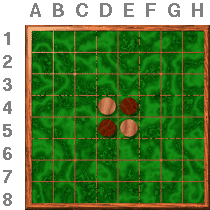
The black side always moves first, then the white side, then again
the Black, turn after turn (see below for special 'pass' condition).
Placing a disc-
- When a player's turn has come, he places a disc of his own color
on a free square of the board, next to an opposite disc.
He also needs to outflank at least one of the
opponent's discs. To outflank means to place a disc on
the board so that your opponent's row (or rows) of disc(s)
is bordered at each end by a disc of your colour. (A
"row" may be made up of one or more discs).
The "trapped discs" are then flipped, so that they turn to the
player's own colour.
For example, the Black first moves to F5:

By playing F5, he outflanks the white disc at E5 between the disc he
places and the black disc already at D5, and therefore flips
the white disc.

Black also could have played E6, C4 or D3. Notice that these 4 moves
are perfectly symetric with each other. Thus, the black side
does not need pondering too much on the initial move.
Placing a disc (2)- Now it is White's turn. He has three possibilities. Indeed, it
is obligatory to flip at least one of the opposite disc at a
time. Therefore, White can play F4, F6 or D6.
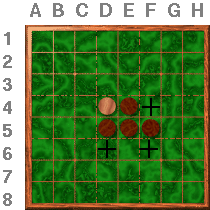
White can play F4, F6 or D6
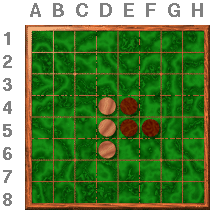
White played D6
Discs can be outflanked in eight directions. On the top of that,
several discs can be outflanked (and flipped) at once.
Placing a disc (3)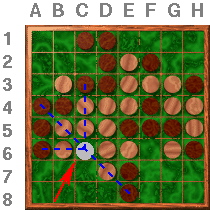
Black play C6
The Black played C6. He flips B6 (outflanked by A6), B5 (thanks to
A4), D7 (thanks to E8) and C4 (thanks to C3). Notice that
neither D6, nor E6 can be flipped because of the free square F6.
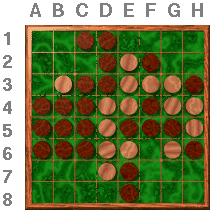
Black played C6 and fliped B6 B5 D7 C4
Placing a disc (4)- There is no chain reaction: flipped discs cannot be used to
flip others within the same turn.
Thus, on the next thumbnail, Black plays A5, flips B5 and C5 which
are outflanked.
Though C4 gets outflanked, he will not be flanked because he has not
been outflanked by the last placed disc and another disc.

Black playing A5...
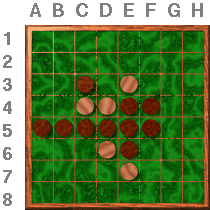
but C4 is still White
If, within your turn, you cannot place a disc by flipping an
opposite one, you pass, thus its up to your opponent to move.
On the other hand, you cannot refuse to flip opposite discs if you
have the opportunity to do so.
Ending the game- The game is over when none of the players can play.
Usually, the game is over when all 64 squares are
occupied. Nevertheless, it can happen that some squares remain
where neither of the players can play.
For example, when all the discs turn to the same color after a
flip. Or, as depicted below, if none of the players can play B1
because no f lip is possible.

In such cases, discs are added on each side to know the score. Free
squares are added to the winner's score. In the game above,
White scores 29 and Black 24 plus one free square. Black
therefore wins over White by 35 to 29.
|
|


